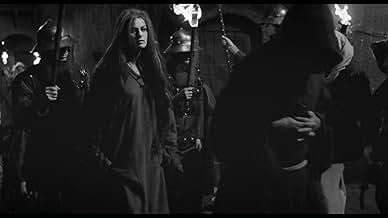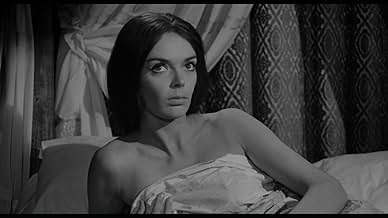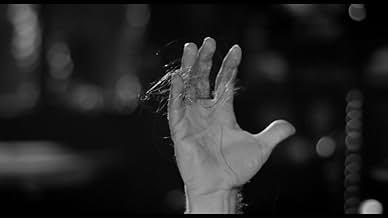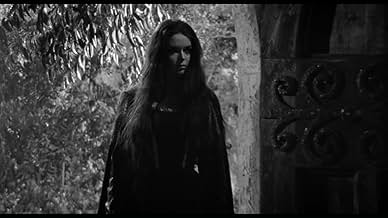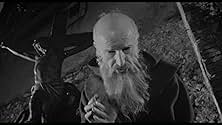Agrega una trama en tu idiomaA woman under suspicion of witchcraft is burned alive. Her curse brings her back from the dead for revenge.A woman under suspicion of witchcraft is burned alive. Her curse brings her back from the dead for revenge.A woman under suspicion of witchcraft is burned alive. Her curse brings her back from the dead for revenge.
- Dirección
- Guionistas
- Elenco
Umberto Raho
- Von Klage, the Priest
- (as Robert Rains)
Laura Nucci
- Grumalda
- (as Laureen Nuyen)
Giuliano Raffaelli
- Count Humboldt
- (as Jean Rafferty)
Nello Pazzafini
- Monk, the Servant
- (as John Carey)
Aldo Barozzi
- Plague Victim
- (sin créditos)
Mario Casella
- Gorca
- (sin créditos)
Severino D'Ottavi
- Party Guest
- (sin créditos)
Alba Maiolini
- Wife of Plague Victim
- (sin créditos)
Aldo Massasso
- The Priest
- (sin créditos)
Enzo Mondino
- Villager at the Execution
- (sin créditos)
Piero Pastore
- Baron Von Letz
- (sin créditos)
Sylvia Sorrente
- Gorca's Wife
- (sin créditos)
Terry Velasco
- Gorca's Daughter
- (sin créditos)
Opiniones destacadas
The Long Hair of Death was one of the cycle of Gothic horror films released by Italian studios in the 1960's. Like the majority of them, it was filmed in black and white for budget reasons although from today's perspective this does give the film a certain atmosphere and classy look. Set in the 15th century, a young woman is accused of being a witch and is burned to death. She casts a curse on the house of the men responsible and returns from the grave many years later to enact deadly revenge.
The director here was Antonio Margheriti working under his anglicised moniker Anthony Dawson. Margheriti was a director who made films in most of the Italian genres, from peplums and spaghetti westerns to gialli and poliziotteschi amongst others. He displays some care with the Gothic horror genre taking care to build a moody atmosphere and slowly constructing the story. But the main draw here is probably Barbara Steele. This British actress was the queen of the 60's Gothic horror film, appearing in movies from both sides of the Atlantic although she is primarily associated with the Italian strain of the sub-genre. Her strong, seductive features were perfectly suited to these films and, once again, she is more aggressor than victim here.
This is a fairly typical entry in the Italian Gothic sub-set. It's a solid entry, if not in the upper bracket. It does have some well-staged scenes and nice location photography though and it ends on a satisfyingly macabre note. While it obviously benefits considerably by the presence of Steele. The title doesn't really mean an awful lot but it sounds good.
The director here was Antonio Margheriti working under his anglicised moniker Anthony Dawson. Margheriti was a director who made films in most of the Italian genres, from peplums and spaghetti westerns to gialli and poliziotteschi amongst others. He displays some care with the Gothic horror genre taking care to build a moody atmosphere and slowly constructing the story. But the main draw here is probably Barbara Steele. This British actress was the queen of the 60's Gothic horror film, appearing in movies from both sides of the Atlantic although she is primarily associated with the Italian strain of the sub-genre. Her strong, seductive features were perfectly suited to these films and, once again, she is more aggressor than victim here.
This is a fairly typical entry in the Italian Gothic sub-set. It's a solid entry, if not in the upper bracket. It does have some well-staged scenes and nice location photography though and it ends on a satisfyingly macabre note. While it obviously benefits considerably by the presence of Steele. The title doesn't really mean an awful lot but it sounds good.
A woman is burned for being a witch. Her daughter, Helen Karnstein (Barbara Steele) vows revenge, but is pushed off a cliff before she can carry it out. The younger sister, Elizabeth (Halina Zalewska), grows up and is forced to marry the man who framed her mother. Then one stormy night, Helen rises from the grave. Elizabeth's husband immediately falls for Helen and together they plot to get rid of Elizabeth. Will Helen really help kill her sister, or is it part of a plot to finally get revenge for her mother's death?
If you're a fan of either Italian B&W ghost stories or Barbara Steele, there's a lot here to enjoy. There's just something about B&W that seems to work for me in a ghost story. B&W makes Gothic lookwell, more Gothic. Color never works as well for me with this kind of movie. The eerie passageways of the castle, the witch burning scene, and the dead corpses in the burial chamber are especially creepy in The Long Hair of Death. But my favorite scene, filmed in all its B&W glory, has to be Helen's appearance in the chapel after having been brought back from the dead. To quote Martha Stewart, "It's a good thing."
Barbara Steele made a boatload of horror films that I enjoy. In fact, she's in my all time favorite - Black Sunday. I have no way of knowing if this is true, but she appears to be having more fun with her role in The Long Hair of Death than I've noticed in some of her other movies. Regardless, there's no denying how mesmerizing she is here. It's impossible not to focus on her in every scene in which she appears.
I suppose I should give the usual warning to those more accustomed to the pace of modern horror. The Long Hair of Death is slow going. Those who require a killing or an explosion every five minutes should probably just skip it.
If you're a fan of either Italian B&W ghost stories or Barbara Steele, there's a lot here to enjoy. There's just something about B&W that seems to work for me in a ghost story. B&W makes Gothic lookwell, more Gothic. Color never works as well for me with this kind of movie. The eerie passageways of the castle, the witch burning scene, and the dead corpses in the burial chamber are especially creepy in The Long Hair of Death. But my favorite scene, filmed in all its B&W glory, has to be Helen's appearance in the chapel after having been brought back from the dead. To quote Martha Stewart, "It's a good thing."
Barbara Steele made a boatload of horror films that I enjoy. In fact, she's in my all time favorite - Black Sunday. I have no way of knowing if this is true, but she appears to be having more fun with her role in The Long Hair of Death than I've noticed in some of her other movies. Regardless, there's no denying how mesmerizing she is here. It's impossible not to focus on her in every scene in which she appears.
I suppose I should give the usual warning to those more accustomed to the pace of modern horror. The Long Hair of Death is slow going. Those who require a killing or an explosion every five minutes should probably just skip it.
Long Hair of Death is a great film. I have to disagree with other reviewers regarding this, both those here on the IMDb and some in printed publications. This is 1960s Italian horror at its very best and, to me, that means it is among the very best, period. I can understand why many in today's impatient, multi-task oriented audience would not like slow moving, atmospheric films which are very dull compared to the current era's action and gore oriented offerings. Films such as these require a cultivated taste of sorts and I realize they are not for everybody.
Long Hair of Death is outstanding because it is exactly what those who do not like it say that it is. It is slow moving, contains little action and there are long periods of -- not much. Not much, except for a feeling of dread and unease that begins immediately after the story begins and does not end until literally the film's end. The slowness is the main reason the viewer sits in uncomfortable agony waiting for something bad to happen, which eventually does.
The story concerns a woman burnt at the stake in 16th century Italy, falsely accused of murder. That she happens to be a count's wife and the count's son the real villain of the story are of great importance in the storyline. Giorgio Ardisson as the evil Kurt Humboldt is one of the big screen's most despicable characters, as throughout the film he commits multiple murder and rape, but sadly most persons not interested in obscure cinema will never know this or experience his splendid performance. The great Barbara Steele (How I wish she had done a greater body of work!) plays a dual role, her characters being pretty much the same as they were in 1960's Black Sunday, (La Maschera del Demonio), as Helen Karnstein, wife of Count Humboldt and also as her daughter Mary. Again, the story is pretty much the same as Black Sunday, with the emphasis being on the executed Helen and the curse she places upon the Count and his son Kurt Humboldt. Daughter Mary, who is a lookalike for her mother, assists in the revenge by playing upon the Count's guilt to destroy him emotionally and getting Kurt to fall in love with her. The fact that Kurt is already married to Mary's sister Elizabeth, herself abused by Kurt, adds dramatically to the sense of moral decay in the Humboldt castle.
The ultimate revenge is as creative as it is brutal. Watch the film to see what it is, I won't provide SPOILERS here.
Barbara Steele remains to this day the standard which all horror (scream) queens are judged, and that is interesting because she does very little screaming and performs little if any violence in her films. She is to horror acting what Alfred Hitchcock was to suspense directing. They frighten you with "What if . . . ," instead of actual brutality and exaggerated acting. From the moment she first appears on screen in any of her films one knows trouble will soon follow and it has nothing to do with anything she says or does. Whatever "it" is, she has it in abundance. Long Hair of Death will remind some viewers of 1972's Lisa and the Devil, (Lisa e il Diavolo) another story of a decaying household but set to modern times. One wonders how much better that film would have been with Ms. Steele in the lead instead of Elke Sommer, a fine actress but out of her depth in psychological horror.
Director Antonio Margheriti has never received the credit he deserves as a fine director of subdued horror. Margheriti will take you on a painstaking walk through the dreariest of castles and make you feel the suspense of every hesitant step and so it is with Long hair of Death. I recently viewed Long Hair of Death after having not seen it in awhile and was emotionally drained by the time the end credits rolled.
If you are unfamiliar with this type of film and are unimpressed with the sensationalism of today's cinema, then find Long Hair of Death or any of the other fine films of Margheriti or Mario Bava. I believe you will be pleasantly surprised and join me in my admiration of Italian horror cinema of this period.
Long Hair of Death is outstanding because it is exactly what those who do not like it say that it is. It is slow moving, contains little action and there are long periods of -- not much. Not much, except for a feeling of dread and unease that begins immediately after the story begins and does not end until literally the film's end. The slowness is the main reason the viewer sits in uncomfortable agony waiting for something bad to happen, which eventually does.
The story concerns a woman burnt at the stake in 16th century Italy, falsely accused of murder. That she happens to be a count's wife and the count's son the real villain of the story are of great importance in the storyline. Giorgio Ardisson as the evil Kurt Humboldt is one of the big screen's most despicable characters, as throughout the film he commits multiple murder and rape, but sadly most persons not interested in obscure cinema will never know this or experience his splendid performance. The great Barbara Steele (How I wish she had done a greater body of work!) plays a dual role, her characters being pretty much the same as they were in 1960's Black Sunday, (La Maschera del Demonio), as Helen Karnstein, wife of Count Humboldt and also as her daughter Mary. Again, the story is pretty much the same as Black Sunday, with the emphasis being on the executed Helen and the curse she places upon the Count and his son Kurt Humboldt. Daughter Mary, who is a lookalike for her mother, assists in the revenge by playing upon the Count's guilt to destroy him emotionally and getting Kurt to fall in love with her. The fact that Kurt is already married to Mary's sister Elizabeth, herself abused by Kurt, adds dramatically to the sense of moral decay in the Humboldt castle.
The ultimate revenge is as creative as it is brutal. Watch the film to see what it is, I won't provide SPOILERS here.
Barbara Steele remains to this day the standard which all horror (scream) queens are judged, and that is interesting because she does very little screaming and performs little if any violence in her films. She is to horror acting what Alfred Hitchcock was to suspense directing. They frighten you with "What if . . . ," instead of actual brutality and exaggerated acting. From the moment she first appears on screen in any of her films one knows trouble will soon follow and it has nothing to do with anything she says or does. Whatever "it" is, she has it in abundance. Long Hair of Death will remind some viewers of 1972's Lisa and the Devil, (Lisa e il Diavolo) another story of a decaying household but set to modern times. One wonders how much better that film would have been with Ms. Steele in the lead instead of Elke Sommer, a fine actress but out of her depth in psychological horror.
Director Antonio Margheriti has never received the credit he deserves as a fine director of subdued horror. Margheriti will take you on a painstaking walk through the dreariest of castles and make you feel the suspense of every hesitant step and so it is with Long hair of Death. I recently viewed Long Hair of Death after having not seen it in awhile and was emotionally drained by the time the end credits rolled.
If you are unfamiliar with this type of film and are unimpressed with the sensationalism of today's cinema, then find Long Hair of Death or any of the other fine films of Margheriti or Mario Bava. I believe you will be pleasantly surprised and join me in my admiration of Italian horror cinema of this period.
I think this is one of Barbara Steele's better horror films. It does have a creepy Gothic atmosphere - and great Gothic music to go with it. I like quite a few of the Italian horror films from the 1960s - 1970s - this is one of them.
This film surrounds a witch and lust. A woman with two daughters is taunted by a man who lusts for her - so much so he would force her into making love to him. She refuses him and is accused of witchcraft and therefor put to death. The older daughter is later put to death and leaving the youngest daughter alive. She grows up and marries... later on the older daughter (apparently a witch) comes back from the dead to seek revenge on those who harmed her family.
Good late night flick!!
7/10
This film surrounds a witch and lust. A woman with two daughters is taunted by a man who lusts for her - so much so he would force her into making love to him. She refuses him and is accused of witchcraft and therefor put to death. The older daughter is later put to death and leaving the youngest daughter alive. She grows up and marries... later on the older daughter (apparently a witch) comes back from the dead to seek revenge on those who harmed her family.
Good late night flick!!
7/10
"I lunghi capelli della morte" by Antonio Margheriti is a classic b/w Gothic movie. Take a flickering candle, go down into the crypt, past the spider webs - and you wouldn't be surprised if Bela Lugosi was lurking in the shadow. Actually it's Barbara Steele which you can't complain about, either. Giorgio Ardisson plays Kurt, the son of a Count, who commits a murder, blames it on a witch, the witch is burnt and leaves a terrible curse behind - maybe the story is not something new, but it matters most in this movie to show how a man is slowly trapped in a revenge plan - so slowly that for most of the running time, he doesn't even realize the torment already began. That not much is happening, as sometimes reviewers do say, is done on purpose: Kurt would like to move, but he is becoming aware more and more of his helplessness, his inability to hide. "I lunghi capelli della morte" is a movie with intensity, atmosphere and beauty in its black and white imagery, and while I just wanted to check out the first chapter for the disc quality when the DVD arrived in the mail, I ended up watching it till the end - it was mesmerizing and really that good. Fans of the genre, don't miss it!
¿Sabías que…?
- ErroresObvious doll is used to replace the actress at the start of the movie in the burning scene.
- ConexionesFeatured in Moviedrome: Long Hair of Death (I Lunghi Capelli Della Morte) (1988)
Selecciones populares
Inicia sesión para calificar y agrega a la lista de videos para obtener recomendaciones personalizadas
- How long is The Long Hair of Death?Con tecnología de Alexa
Detalles
- Tiempo de ejecución1 hora 36 minutos
- Color
- Relación de aspecto
- 1.85 : 1
Contribuir a esta página
Sugiere una edición o agrega el contenido que falta

Principales brechas de datos
What is the Spanish language plot outline for I lunghi capelli della morte (1964)?
Responda
